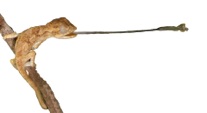Chameleon Care &
Information Center (CCIC)
Chameleon Care &
Information Center (CCIC)



General Captive Considerations:
There are a number of considerations one must make and understand before attempting to keep and while keeping chameleons. Failure to realize and react to these considerations can lead to death or suffering of captive specimens. Failure to respond appropriately is extremely neglectful and cruel.
Chameleons are not easy animals to keep. In general, they are not good candidates for novice reptile keepers and must be handled and cared for with extreme care. They are generally not good candidates as gifts or pets for children (see article Kids and Chameleons). Their care requirements are specific and with most species, non-forgiving. As a result, extensive research prior to purchase and consideration of the appropriateness of keeping a chameleon is critical.
As mentioned in the “General Behavior” section of this site, chameleons are shy animals. They generally should be kept individually with the exception of Brookesiinae species and during breeding (See article, Cohabitation). In general, they do not appreciate being handled and should be considered a look but don’t touch animal. Similarly, they should be kept in low traffic areas with minimal disturbances from other animals or people. Due to their arboreal nature, they feel most comfortable when they are above their keepers and other disturbances. As a result, it is recommended that their enclosures be elevated to a point where they can be above eye level if they desire.
Chameleons tend to do best with minimal contact and interaction but at the same time, a certain degree of monitoring and exposure is needed. Use of timers and misting systems can be very beneficial in ensuring consistency in care and decreasing stress from constant contact with their caretaker.
Chameleons are very expensive to maintain effectively. The cost of the actual animal is only a small portion of the cost of keeping the animal. One should always budget for vet expenses, caging costs, feeding costs, etc. The following article is a very good idea of how much keeping chameleons can cost: Costs of Keeping Chameleons.
Care should be taken when choosing the species and specimen to purchase. Novices should avoid neonates, wild caught (WC) specimens and stick to species generally considered good beginner species. Such species include the veiled chameleon (Chamaeleo calyptratus), the panther chameleon (Furcifer pardalis) and slightly more demanding, the Jackson’s chameleon (Trioceros jacksonii xantholophus).
In the end of the day, we are truly ignorant about the real requirements of these animals. We are only able to begin to provide sufficient environments for them and we should do absolutely everything in our power to minimize stress and should always use care methods that are known to be superior over what may be simpler, but not as effective. One should learn over time to observe with minimal intrusion. Since every animal is different and subject to their own preferences, this should be done on an individual level although extensive knowledge of the species is also vital. Careful attention to detail is crucial for success.
Captive Considerations
Copyright © 1998-2014 Christopher V. Anderson. All Rights Reserved.
Reproduction in whole or part is expressly forbidden without written permission.
For permission, please contact Christopher V. Anderson at cvanders@mail.usf.edu